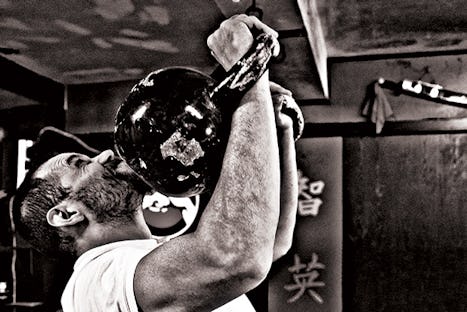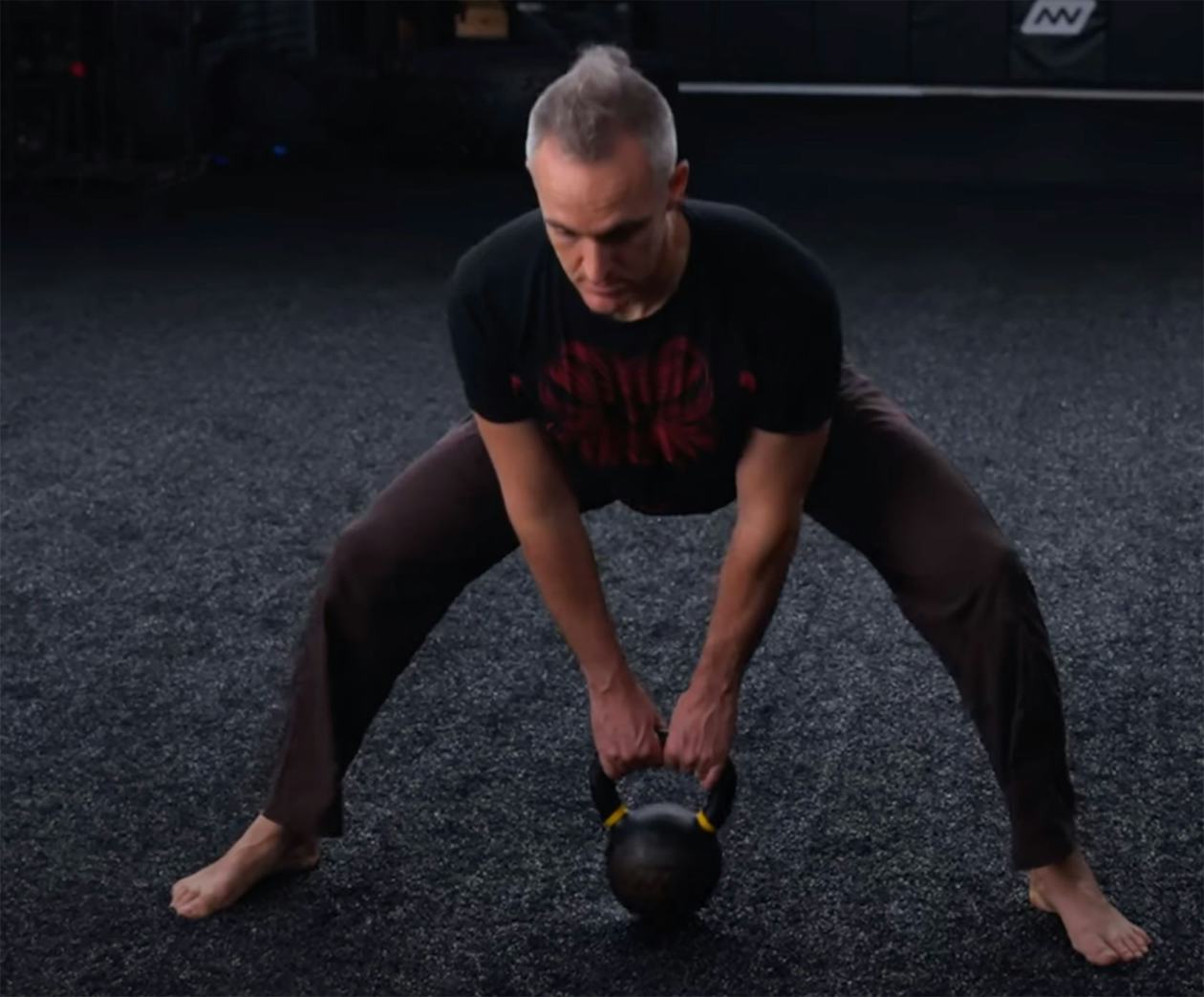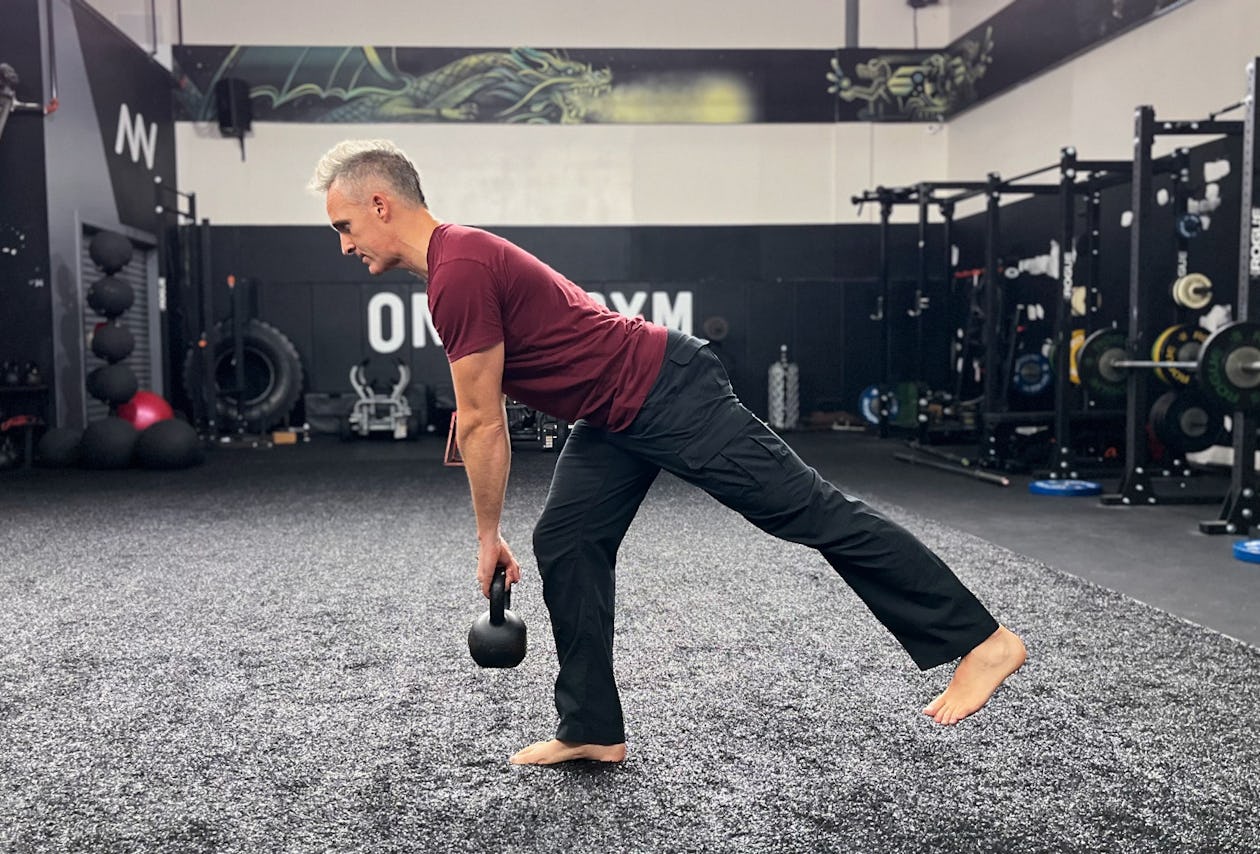The humble kettlebell has been the cornerstone of my training and that of my athletes for several years now.
While most people simply use kettlebells for conditioning purposes, performing high rep swings, snatches, or doing circuits and complexes, we also use them for true strength purposes.
The majority of my athletes are involved in contact sports, be that the martial arts, rugby, or Irelands native GAA games.
Needless to say, these guys need strength and power by the bucket load, but not at the expense of speed and agility. While I use a variety of training tools with all my guys, much of what we do revolves around the kettlebell.
There are certain distinct advantages to using the kettlebell for strength over the more conventional barbell. This is especially evident in the squat and the overhead press. Let’s examine what that means.
Kettlebell vs. Barbell
The Kettlebell Overhead Press

The Overhead Press has always been a marker for strength. For anyone with a few miles on the clock, it can also be problematic.
Personally, I can’t even watch someone Military Press a barbell without having to visit the physio afterward, and several of my crew have had a similar predicament.
That said, we all press kettlebells overhead with little or no trouble. I’m no physio so I can’t offer you a valid explanation of why this is the case, I can only hazard a few guesses.
The first is that the kettlebells are separate, allowing for the shoulder to move in a more natural plane, even a plane that is unique to its structure; a barbell doesn’t allow this.
The next observation is the position of the kettlebell on the arm; the weight is below and behind the hand rather than in it. This changes the leverage; many suggest this offers greater stimulation to the rotator cuff muscles.
My opinion is in the actual technique employed in a Kettlebell Overhead Press. Pay attention now; this is going to get detailed.
When racked, the kettlebells should be low on the body; ideally, the elbows are resting on the top of the hip bones. To get here, we must shift the torso back a wee bit and sink the chest a little.
This position requires flexibility in the thoracic spine and hip flexors, two very common tight areas (so we’re off to a good start already).
We initiate the actual lift with an exhale. This will further sink the chest, spring loading the upper back. As we take a sharp breath in to expand the chest, we throw the head back to extend the thoracic spine and open the rib cage.
As the back contracts to lift the chest, the arms are taken along for the ride and the kettlebells are set on their path skywards.
Just be careful not to lean back through the lower back; keep the abs a little tight and activate the glutes to ensure the core is solid and the upper back does most of the work.
Once the spine is fully extended, the arms and shoulders kick in. If the body is flexible, the initial part of the press is almost horizontal relative the thoracic spine. It is almost as if we are pushing ourselves away from the kettlebells rather than trying to lift them.
So far we’ve used the breath and the back to set the kettlebells in motion, and now our upper chest can kick in. If you’ve done things right so far, the chest is stretched and begging to contract. Boom! In kicks the chest and abs.
This motion slingshots the spine and the head forwards under the kettlebells so our shoulders and triceps can do the simple job of locking them out with a strong exhale to stabilize the body and receive the weight.
Got it? Good. It took me a long time to work all that out, as well as studying the technique of top kettlebell lifters and also the method that strongmen employ in the log lift, which is almost identical.
Altogether, this makes the kettlebell overhead press a massive lift for the entire upper body but is very forgiving for the shoulder joint.
The Kettlebell Squat
The Squat is considered the king of the weight room exercises, and for a good reason. Few lifts have such a profound effect on the body as getting under some serious iron and squatting it.
While we do use the Barbell Squat, many of the athletes do better without it and instead substitute the kettlebell front squat and the Bulgarian split squat with the kettlebells held by the sides.
The Split Squat is my go-to exercise for leg strength; it is brutally hard yet relatively low risk. The weight is held low below the body’s center of gravity, so the spine isn’t overloaded, yet the legs are working to near maximum capacity.
Alongside this, we also get to see and address any imbalances between the left and right legs, something which is very common as most guys favor one side in their athletic performance.
Next, comes the Double Kettlebell Front Squat. The advantage with the Double Front Squat is that the kettlebells are front loaded, changing the center of gravity in the body and forcing a more upright squatting position.
This upright position and front load takes a lot of strain away from the lower back and places it firmly onto the abs. Many who attempt heavy Front Squats with kettlebells are surprised to find that their upper back and abs are highlighted as their weak points.
As you can imagine, if you train to both give and receive big hits, the upper back and core have to be made of spring steel. The Double Kettlebell Front Squat will achieve this.
The Kettlebell Deadlift
For our posterior chain, the Barbell Deadlift is still one of your best options, but we get on well with Single Leg Romanian Deadlift using a pair of kettlebells as well. We also use the Double Swing and Double Snatch.
The ballistic kettlebell lifts are easier to learn than their Olympic counterparts and also have one distinct advantage when we are talking about athletic strength and power development.
The pendulum-like action of the kettlebell ballistics utilizes the stretch reflex as the kettlebells reach the furthest point of the backswing and reverse their direction. This makes heavy kettlebell work almost plyometric in action.
Now, run that through for a second. You can get a plyometric response with little to no joint impact while at the same time throwing a significant amount of weight through lots of space. Now that’s a winner in my book.
Kettlebell Strength Progression
When it comes to progressing the weight with kettlebells, we have to take a different tactic than in more conventional methods. Kettlebells are a fixed weight and traditionally go up in 4kg increments.
That means that for one of my female kickboxers to go from Snatching a pair of 8kg kettlebells to the next size up (12kg), that’s a 50% jump! Where else in the training world would you see that?
Now, admittedly a jump from a pair of 36kg’s to a pair of 40kg’s is the same weight increase (8kg), but it’s only an 11% increase which much more acceptable. In general, we work on building volume before adding weight.
This is also mildly safer for the athlete as they must first master a certain weight before being allowed to move up.
Kettlebell Strength Sets
For strength, we often start with lower reps like 3 for 2-3 sets, then add a set without changing the rep range. Then we slowly add in more reps until we are hitting the upper end of the bracket for all sets.
Only now do we allow a weight change. For a person military pressing the 24kg kettlebell for 3 x 3, we encourage them to work towards 5 x 3, then 5 x 4 and eventually 5 x 5 before letting them go for the 28kgs.
4-Day Kettlebell Strength & Power Program
The following is a sample 4-day kettlebell strength and power program. It’s been used by several of my Grapplers, Rugby Players, and GAA guys, all of whom report a massive increase in tackling power and increased resistance to injury.
Day 1: Hips
A: Double Kettlebell Snatch x 3 x 5
B1: 1-Leg Romanian Deadlift x 4-6 L/R x 3 – 5
B2: Hanging Leg Raise x 6-8 x 3
C: Heavy Alternating Swing x 100 changes[/tab]
Day 2: Vertical Press
A1: Double Kettlebell Clean & Press x 3-5 x 3-5
A2: Double Kettlebell 11Arm Row x 3-5 x 3-5
B1: SeeSaw Press x 6-8 x 3
B2: Alternating Row x 6-8 x 3
C: Hindu Push Ups x 50[/tab]
Day 3: Squat
A: Squat Jumps x 3 x 3
B: Bulgarian Split Squat x 4-6 L/R x 3-5
C1: Double Kettlebell Clean to Squat x 6-8 x 3
C2: Reuben Abs x 6-8 each way x 3
D: Hindu Squat x 100[/tab]
Day 4: Horizontal Press
A: Plyo Push Ups x 3 x 3
B1: Kettlebell Floor Press x 3-5 x 3-5
B2: Weighted Chin Up x 3-5 x 3-5
C: Heavy Turkish Get Up x 5 min (Alternate)
D: Push Up x 50



